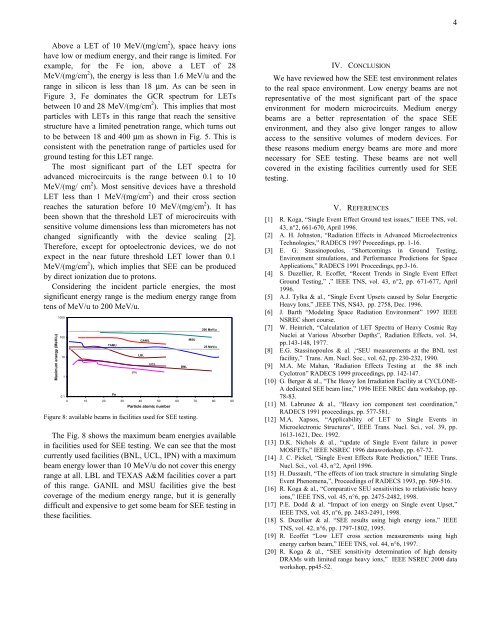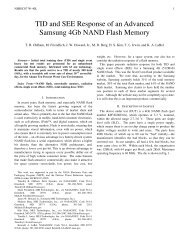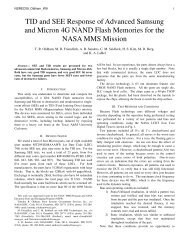(SEE) Testing - Radiation Effects & Analysis Home Page - NASA
(SEE) Testing - Radiation Effects & Analysis Home Page - NASA
(SEE) Testing - Radiation Effects & Analysis Home Page - NASA
You also want an ePaper? Increase the reach of your titles
YUMPU automatically turns print PDFs into web optimized ePapers that Google loves.
Above a LET of 10 MeV/(mg/cm 2 ), space heavy ions<br />
have low or medium energy, and their range is limited. For<br />
example, for the Fe ion, above a LET of 28<br />
MeV/(mg/cm 2 ), the energy is less than 1.6 MeV/u and the<br />
range in silicon is less than 18 μm. As can be seen in<br />
Figure 3, Fe dominates the GCR spectrum for LETs<br />
between 10 and 28 MeV/(mg/cm 2 ). This implies that most<br />
particles with LETs in this range that reach the sensitive<br />
structure have a limited penetration range, which turns out<br />
to be between 18 and 400 μm as shown in Fig. 5. This is<br />
consistent with the penetration range of particles used for<br />
ground testing for this LET range.<br />
The most significant part of the LET spectra for<br />
advanced microcircuits is the range between 0.1 to 10<br />
MeV/(mg/ cm 2 ). Most sensitive devices have a threshold<br />
LET less than 1 MeV/(mg/cm 2 ) and their cross section<br />
reaches the saturation before 10 MeV/(mg/cm 2 ). It has<br />
been shown that the threshold LET of microcircuits with<br />
sensitive volume dimensions less than micrometers has not<br />
changed significantly with the device scaling [2].<br />
Therefore, except for optoelectronic devices, we do not<br />
expect in the near future threshold LET lower than 0.1<br />
MeV/(mg/cm 2 ), which implies that <strong>SEE</strong> can be produced<br />
by direct ionization due to protons.<br />
Considering the incident particle energies, the most<br />
significant energy range is the medium energy range from<br />
tens of MeV/u to 200 MeV/u.<br />
Maximum energy (MeV/u)<br />
1000<br />
100<br />
10<br />
1<br />
0.1<br />
TAMU<br />
Fe<br />
GANIL<br />
200 MeV/u<br />
25 MeV/u<br />
0 10 20 30 40 50 60 70 80 90<br />
Particle atomic number<br />
Figure 8: available beams in facilities used for <strong>SEE</strong> testing.<br />
IPN<br />
LBL<br />
The Fig. 8 shows the maximum beam energies available<br />
in facilities used for <strong>SEE</strong> testing. We can see that the most<br />
currently used facilities (BNL, UCL, IPN) with a maximum<br />
beam energy lower than 10 MeV/u do not cover this energy<br />
range at all. LBL and TEXAS A&M facilities cover a part<br />
of this range. GANIL and MSU facilities give the best<br />
coverage of the medium energy range, but it is generally<br />
difficult and expensive to get some beam for <strong>SEE</strong> testing in<br />
these facilities.<br />
UCL<br />
BNL<br />
MSU<br />
IV. CONCLUSION<br />
We have reviewed how the <strong>SEE</strong> test environment relates<br />
to the real space environment. Low energy beams are not<br />
representative of the most significant part of the space<br />
environment for modern microcircuits. Medium energy<br />
beams are a better representation of the space <strong>SEE</strong><br />
environment, and they also give longer ranges to allow<br />
access to the sensitive volumes of modern devices. For<br />
these reasons medium energy beams are more and more<br />
necessary for <strong>SEE</strong> testing. These beams are not well<br />
covered in the existing facilities currently used for <strong>SEE</strong><br />
testing.<br />
V. REFERENCES<br />
[1] R. Koga, “Single Event Effect Ground test issues,” IEEE TNS, vol.<br />
43, n°2, 661-670, April 1996.<br />
[2] A. H. Johnston, “<strong>Radiation</strong> <strong>Effects</strong> in Advanced Microelectronics<br />
Technologies,” RADECS 1997 Proceedings, pp. 1-16.<br />
[3] E. G. Stassinopoulos, “Shortcomings in Ground <strong>Testing</strong>,<br />
Environment simulations, and Performance Predictions for Space<br />
Applications,” RADECS 1991 Proceedings, pp.3-16.<br />
[4] S. Duzellier, R. Ecoffet, “Recent Trends in Single Event Effect<br />
Ground <strong>Testing</strong>,” ,” IEEE TNS, vol. 43, n°2, pp. 671-677, April<br />
1996.<br />
[5] A.J. Tylka & al., “Single Event Upsets caused by Solar Energetic<br />
Heavy Ions,” ,IEEE TNS, NS43, pp. 2758, Dec. 1996.<br />
[6] J. Barth “Modeling Space <strong>Radiation</strong> Environment” 1997 IEEE<br />
NSREC short course.<br />
[7] W. Heinrich, “Calculation of LET Spectra of Heavy Cosmic Ray<br />
Nuclei at Various Absorber Depths”, <strong>Radiation</strong> <strong>Effects</strong>, vol. 34,<br />
pp.143-148, 1977.<br />
[8] E.G. Stassinopoulos & al. ,“SEU measurements at the BNL test<br />
facility,” Trans. Am. Nucl. Soc., vol. 62, pp. 230-232, 1990.<br />
[9] M.A. Mc Mahan, ‘<strong>Radiation</strong> <strong>Effects</strong> <strong>Testing</strong> at the 88 inch<br />
Cyclotron” RADECS 1999 proceedings, pp. 142-147.<br />
[10] G. Berger & al., “The Heavy Ion Irradiation Facility at CYCLONE-<br />
A dedicated <strong>SEE</strong> beam line,” 1996 IEEE NREC data workshop, pp.<br />
78-83.<br />
[11] M. Labrunee & al., “Heavy ion component test coordination,”<br />
RADECS 1991 proceedings, pp. 577-581.<br />
[12] M.A. Xapsos, “Applicability of LET to Single Events in<br />
Microelectronic Structures”, IEEE Trans. Nucl. Sci., vol. 39, pp.<br />
1613-1621, Dec. 1992.<br />
[13] D.K. Nichols & al., “update of Single Event failure in power<br />
MOSFETs,” IEEE NSREC 1996 dataworkshop, pp. 67-72.<br />
[14] J. C. Pickel, “Single Event <strong>Effects</strong> Rate Prediction,” IEEE Trans.<br />
Nucl. Sci., vol. 43, n°2, April 1996.<br />
[15] H. Dussault, “The effects of ion track structure in simulating Single<br />
Event Phenomena,”, Proceedings of RADECS 1993, pp. 509-516.<br />
[16] R. Koga & al., “Comparative SEU sensitivities to relativistic heavy<br />
ions,” IEEE TNS, vol. 45, n°6, pp. 2475-2482, 1998.<br />
[17] P.E. Dodd & al. “Impact of ion energy on Single event Upset,”<br />
IEEE TNS, vol. 45, n°6, pp. 2483-2491, 1998.<br />
[18] S. Duzellier & al. “<strong>SEE</strong> results using high energy ions,” IEEE<br />
TNS, vol. 42, n°6, pp. 1797-1802, 1995.<br />
[19] R. Ecoffet “Low LET cross section measurements using high<br />
energy carbon beam,” IEEE TNS, vol. 44, n°6, 1997.<br />
[20] R. Koga & al., “<strong>SEE</strong> sensitivity determination of high density<br />
DRAMs with limited range heavy ions,” IEEE NSREC 2000 data<br />
workshop, pp45-52.<br />
4




